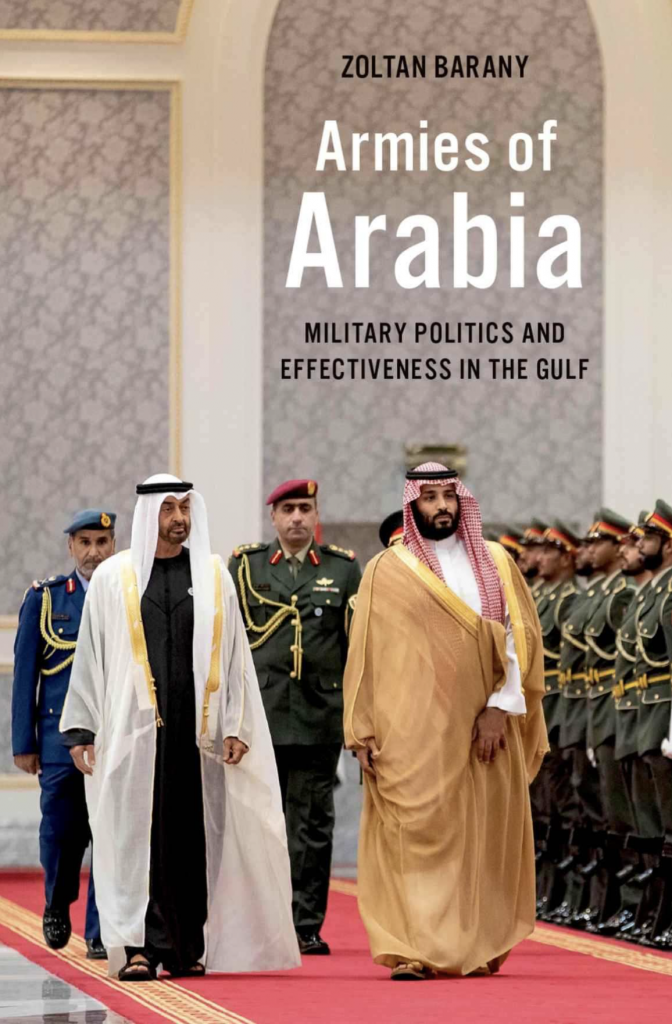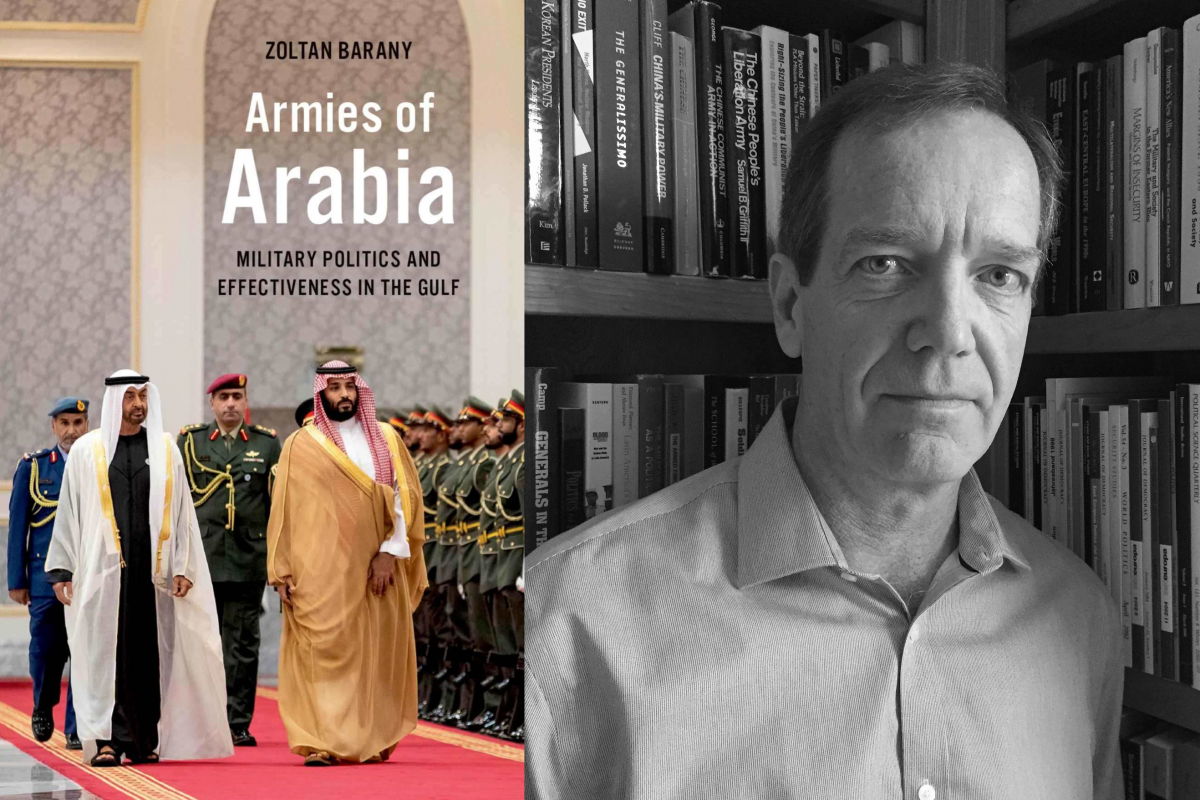The following is an excerpt from Armies of Arabia: Military Politics and Effectiveness in the Gulf by Zoltan Barany, professor of government at The University of Texas at Austin. The book was published by Oxford University Press in September 2021. It is the first comprehensive analysis of the Gulf monarchies’ armed forces, including their political, social, and economic characteristics, foreign relations, and battleground performance.
Following the Iran-Iraq War (1980–1988), Iraqi dictator Saddam Hussein continued to maintain over 850,000 men in uniform and a bloated defense budget (between $7 and $10 billion annually), notwithstanding Iraq’s approximately $80 billion debt. Most of this liability was owed to Kuwait, Saudi Arabia, and other Gulf states— which supported Baghdad during the war— but Saddam argued that his army saved these monarchies from Iran’s designs on them and was reluctant to meet his obligations.
Iraqi politicians, in fact, had long claimed that Kuwait “belonged to Iraq” and that it was merely an artificial creation of British colonialism with arbitrarily drawn borders. Now they charged that Kuwait’s increasing production depressed the world market price of oil, thereby aggravating Iraq’s financial predicament.
On August 2, 1990, Saddam decided to solve this quandary by invading the oil-rich, and militarily weak, Kuwait, starting another war that it planned to expand to Saudi Arabia and the rest of the Gulf Arab states.
Despite Iraq’s several months-long and intensifying saber-rattling, Kuwait proved entirely unprepared for the invasion and the occupation that followed. In late July 1990, Kuwait mobilized its military and placed it on alert but, embarrassingly, few people showed up: reservists did not report to their units and a large number of active-duty army personnel went AWOL.
Many Kuwaiti civilians who stayed behind put up a spirited resistance against the Iraqi occupation forces that executed hundreds of them during their seven-month-long stay. The invasion of Kuwait and the subsequent Gulf War was, in several respects, a formative moment in the politico-military history of the region.
Zoltan Barany, Armies of Arabia
Iraq’s battle-hardened forces brushed aside the Kuwaiti army with little apparent effort. Only Kuwait’s air force was able to inflict some minor losses on Iraqi ground troops before its aircraft withdrew to Saudi Arabia and Bahrain.
Fundamentally, Iraqi troops wrested control over the country on the first day of their well-executed two-day operation. By then the Emir of Kuwait, Jaber Al Ahmad Al Sabah, and two-thirds of the approximately 700,000 Kuwaiti citizens and many of the 1.5 million foreign workers living in the country had already decamped to Saudi Arabia and elsewhere. Many Kuwaiti civilians who stayed behind put up a spirited resistance against the Iraqi occupation forces that executed hundreds of them during their seven-month-long stay. The invasion of Kuwait and the subsequent Gulf War was, in several respects, a formative moment in the politico-military history of the region.
In terms of domestic politics, some signs suggested that the citizenry’s bond with that of the ruling family was weaker than the latter would have desired. Kuwait was an absolute monarchy without even the superficial trapping of popular involvement since 1986, when the Emir revoked the constitution and dissolved parliament. Soon after the invasion began, the feebleness of state institutions— chiefly among them the government and the military— was underscored by their rapid collapse. Following the occupation, the citizenry was divided between those who stayed behind and those who left. One of the lessons Kuwait’s royal family took away from the events was to cautiously expand political participation in order to deepen their subjects’ loyalty to their regimes.
The invasion proved Kuwait’s military hopelessly inadequate even to pose a modest challenge to the Iraqi armed forces, let alone to successfully resist them for any period of time. The army was poorly trained, it was not prepared to fight, and was by many accounts ignorant about the capabilities and maintenance requirements of its own weapons.

A large component— as many as 80 percent— of Kuwaiti military personnel was made up of bidun, the marginalized descendants of northern bedouin tribes who never received citizenship. Perhaps not surprisingly, few of them were willing to sacrifice themselves for the Emir. This point may be extended to much of the region: why should Gulf soldiers be loyal to and fight for the monarchical families when even their citizenship could be revoked? These were, after all, not national armies, but the armies of royal families; their primary raison d’être was to ensure the continued rule of their princes. This recognition, in turn, has led several Gulf states since the invasion of Kuwait to purposefully develop national sentiments in their citizenries and especially in the native members of their armed forces.
Iraq’s war on Kuwait and confrontation of Saudi Arabia also clearly demonstrated to the Saudi royal family that after decades of massive defense outlays— some $300 billion in the previous quarter century— its army was nowhere near capable of defending the Kingdom. According to Ayubi, the invasion “illustrated that these states could not (or would not) defend themselves on their own or with exclusively Arab help.”
After the war, the Saudi high command admitted that Iraq’s elite forces, the Republican Guard, could have occupied the Kingdom’s 200,000 square-mile oil-rich al-Ahsa Governorate in six hours. On August 9, 1990, in a televised speech, King Fahd bin Abdulaziz conceded that Saudi Arabia needed the protection of “fraternal Arab forces and other friendly forces,” in an unprecedented acknowledgment of the Gulf’s reliance on outside support.
King Fahd’s acknowledgment of Saudi military weakness also served to prepare his people for the imminent and unavoidable disruptions that Operation Desert Shield— the arrival of hundreds of thousands of foreign, mostly American, troops and their equipment— would signify. Saudi citizens needed to be warned because they were sure to consider the stationing of infidel soldiers on Saudi soil, the land of the Holy Cities of Mecca and Medina, profoundly humiliating (as Osama bin Laden later explained). In the end, the United States moved over 500,000 troops into the region that were complemented by 35,000 British, 17,000 French, and other Western soldiers. The basing rights Riyadh granted to the United States were terminated thirteen years later— in response to growing internal security concerns caused by opposition to continued non- Muslim troop presence, exemplified by Al- Qaeda’s bombing campaign— after the American- led coalition ousted Saddam in the Second Gulf War.
Following Kuwait’s liberation, the strategic link between the Gulf states and Washington had deepened. A major legacy of the conflict, then, is Arabia’s increased dependence on US weapons, training, and power projection capabilities, and this reliance has only increased in the past three decades.
Armies of Arabia, Zoltan Barany
The poor performance of the Gulf armies in 1990–1991 put their shortcomings in sharp focus. First, desertion among Kuwaiti and Saudi troops was high, although not as widely reported as that of Iraqi soldiers.The inexperienced Kuwaiti, Saudi, and other troops were principally trained to respond to domestic security challenges and, faced with and greatly outnumbered by a far more professional enemy, many likely felt the situation desperate. At the other end of the rank spectrum, Saudi military leaders refused to take responsibility for their actions, blamed others for their own errors, and were unable to make independent decisions. For instance, Iraqi forces occupied the town of Khafji in northeastern Saudi Arabia after Saudi troops evacuated it. General Khalid bin Sultan, the leader of Saudi ground forces, requested a letter from the coalition forces’ commander, US General Norman Schwarzkopf, to the effect that it was Schwarzkopf who ordered the evacuation of the town. Saudi pride required that foreigners be blamed for their own incompetence. It is noteworthy that the record of the Egyptian contingent— consisting of the best units the Egyptian army— was similarly lackluster. Egyptian generals were just as paralyzed with inaction when they had to be decisive as their Saudi colleagues. These legacies of the war point to several of the main themes that will receive further attention in this book.
For the Gulf countries, especially Kuwait and Saudi Arabia, two key takeaways from the Gulf War were the reliability of the United States as a partner and the US military’s power and technological sophistication that allowed it to easily defeat Iraqi forces. To be sure, even prior to 1990 America played a major role as the source of advanced training and weapons for the region, Gulf-US relationships between the two sides were often fraught, primarily owing to Washington’s close alliance with Israel. Following Kuwait’s liberation, the strategic link between the Gulf states and Washington had deepened. A major legacy of the conflict, then, is Arabia’s increased dependence on US weapons, training, and power projection capabilities, and this reliance has only increased in the past three decades. At the same time, the Gulf monarchies have also recognized the benefits of expanding relations, including military links, with new strategic partners and arms suppliers.
Zoltan Barany holds the Frank C. Erwin, Jr. Centennial Professorship in Government. He received his Ph.D. in at the University of Virginia. He is chiefly interested in military politics and democratization worldwide. In the past decade his field research has focused on the Arabian Peninsula and Burma/Myanmar.
